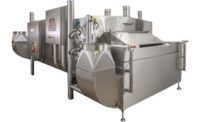Ice-hot!
By Tom Weir
Casual dining’s hot tickets are getting shoppers into the supermarket freezer case.
Retailers looking for what’s going to be hot in fully cooked frozen meat and poultry entrées might want to watch the takeout line at quick-serve restaurants.
That’s where chicken nuggets, steak fingers, and chicken wings got their start before becoming star players in the supermarket’s frozen food department.
“A lot of what’s going on at retail right now is really a couple of years behind what you see in foodservice,” says Billy McPherson, vice president of sales and marketing for Oklahoma City-based Advance Brands, which markets frozen meat and poultry under the Advance Fast Fixin’ and Easy Beginnings brands.
“The majority of the restaurants focus on their product, as opposed to their price,” McPherson says. “The product is what’s driving people to the restaurant. The same thing can happen in the grocery freezer case. If we will focus on the product as opposed to what’s cheap, then we’ll compete with the foodservice operators.”
“Convenience is the key,” says Dan Emery, vice president of marketing at Pilgrim’s Pride, Pittsburg, TX. He notes that popcorn chicken has stolen some of chicken nuggets’ thunder, but points to breast strips as today’s fastest movers.
“We developed a strip for Papa John’s and it went through the roof, so everybody else emulated them — Domino’s, now we’re doing one for Wendy’s — and we can’t make enough breast strips.”
Emery says Pilgrim’s Pride’s standing as a large supplier to quick-service restaurants helps it on top of the latest trends.
John Lea, group vice president, consumer products at Tyson Foods Inc. in Springdale, AR, cautions that while shoppers will accept higher prices for the value of convenience and quality, they still keep an eye on their budgets.
“Consumers will choose alternatives if they feel the high price does not give the overall value,” he says.
“Consumers will choose alternatives if they feel the high price does not give the overall value,” he says.
Lea casts the competition with takeout and fresh meats in terms of meal occasions. The quality and convenience of fully cooked entrées, he says, make them especially attractive to consumers who don’t have time to pick up carry-out meals or cook from scratch. “The real loser may be canned meats and entrées,” he says.
McPherson says the growth of casual dining carry-out is outpacing all other food categories, despite the fact that calling in an order and going to pick it up is not as fast as making a quick meal at home. Today’s higher-quality, more convenient and tasty frozen meals should help turn this around, he says.
Retailers’ deli cases are doing a good job competing with restaurant takeout, and in frozens, fully cooked wings are meeting the challenge, says Greg Moore, director of marketing for Atlanta-based Gold Kist Farms, the farmer-owned poultry cooperative.
But he believes some frozen departments lack quality offerings in such products as whole-muscle, fully cooked breaded tenders. The majority of plain chicken items are breaded, formed, and packaged in boxes, Moore says, adding that deli departments and restaurants often do a better job.
Private-label upswing
Gold Kist supplies fresh chicken to some of the country’s largest supermarket chains, and its strategy includes expanding its private label frozen business as well, says Moore. He notes that some retailers are merchandising the company’s frozen chicken in standup plastic bags and focusing more on quality.
Emery says Pilgrim’s Pride consumers are responding well to bagged product, and Advance Brands’ McPherson says his company got into bags about five years ago because shoppers in focus groups said they wanted them. A container that gets smaller as product is removed helps relieve the space crunch in home freezers.
Bridget Little, marketing manager for Advance Brands, says another edge for bagged product is that consumers can pull out one or two pieces as needed, then re-seal the package. The speed and ease of preparation also make it possible for adults and children to have different entrées at the same meal without a lot of extra work, adds McPherson.
Tyson has seen strong demand for both bags and boxes, says Lea. The company introduced family-pack bags to give consumers a broader choice of servings per package. “Our boxed products usually contained two to four servings per package and were small enough that the average home freezer could accommodate multiple boxes per shelf,” he says. “However, boxes were not really practical for expanded-serving offerings.”
Growth by bagged product has produced little cannibalization of boxed items, which the company attributes to new consumers in the category. Family pack meat and poultry lines are among Tyson’s fastest growing, says Lea.
The current rage for low-carbohydrate, high-protein diets has stimulated demand for meat and poultry, but the diets can’t claim all the credit. Emery points out that some of his fast-growing items are breaded.
However, Little says, “The low-carb trend is very hot. We’re certainly taking advantage of that and suggesting that our retailers do as well.” Advance Brands has put carb-counter stickers on many of its products, but the company hasn’t brought out a low-carb line.
At Tyson, says Lea, “We have seen strong demand for proteins since the fall of last year and a particular spike right after New Year’s. I think we can certainly attribute some of that demand to the popularity of diet programs that focus on animal and vegetable proteins as the major sources of nutrition and energy.” He also gives credit to consumer confidence inspired by medical findings that support the use of animal proteins in sound diets and weight-loss programs.
While chicken has been getting most of the attention, McPherson says he’d like to see retailers putting more beef entrées in their freezer cases. Among his company’s best-sellers, he says, are country fried steak and steak fingers, both developed with an eye to what people were ordering in restaurants. There’s also a Salisbury steak with gravy and a recently added Philly beef steak.
“Comfort food is still a lot of what you’re seeing, especially if you look at our country fried steak sales,” says Little. “People don’t want to fuss and muss, but they want to eat product like that.” np
Tom Weir is a freelance writer based in Passaic, NJ.



Report Abusive Comment